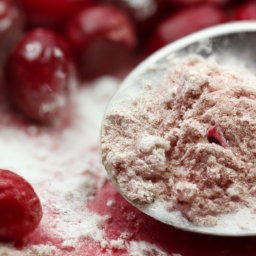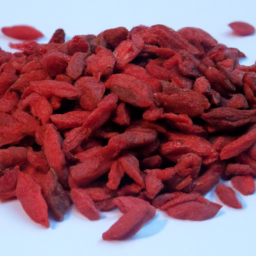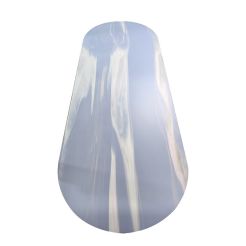Sorbitol Powder - Natural Sweetener
<p>Alias:D-Glucitol, Sorbol, D-Sorbitol</p> <p>Molecular formula: C6H14O6</p> <p>Molecular Mass: 182.17</p> <p>Relative Density:1.49</p> <p>Melting Point:88~102 ℃</p> <p>Appearance:White hygroscopic powder or crystalline powder, flake or particle, odorless</p> <p>Solubility:Easy to dissolve in water (1g soluble in approximately 0.45mL of water), slightly soluble in ethanol and acetic acid.</p>
Product Description
Sorbitol Powder

Sorbitol, also known as D-sorbitol, 50-70-4, E420, and D-glucoside, is a type of carbohydrate. It belongs to a class of sugar alcohols called polyols, slow metabolism in the human body. It can be obtained by reducing glucose, which converts the converted aldehyde group (- CHO) into a primary alcohol group (- CH 2 OH). Most sorbitols are made from potato starch, but they also exist in nature, such as apples, pears, peaches, and plums. Convert it to fructose through sorbitol-6-phosphate 2-dehydrogenase. Sorbitol is an isomer of mannitol, another sugar alcohol; the two differ only in the orientation of the hydroxyl group on carbon 2.While similar, the two sugar alcohols have very different sources in nature, melting points, and uses.

Character: Chemical name is 1,2,3,4,5,6-hexanol, chemical formula is C6H14O6, relative molecular weight is 182.17 (according to 2007 international relative atomic weight), with two optical isomers: D and L. White hygroscopic powder or crystalline powder, flake or particle, odorless; The sales form in the market is in liquid or solid state. Boiling point 494.9 ℃; Depending on the crystallization conditions, the melting point varies within the range of 88~102 ℃; The relative density is about 1.49; Easy to dissolve in water (1g soluble in approximately 0.45mL of water), hot ethanol, methanol, isopropanol, butanol, cyclohexanol, phenol, acetone, acetic acid, and dimethylformamide, slightly soluble in ethanol and acetic acid.
Chemical properties are stable and not easily oxidized by air. It is not easily fermented by various microorganisms, has good heat resistance, and does not decompose at high temperatures (200 ℃). Sorbitol molecules contain six hydroxyl groups that can effectively bind to some free water. Its addition has a certain effect on increasing the moisture content of the product and reducing water activity.
Specifications:
| Product Name | Sorbitol Powder |
| Alias | D-Glucitol, Sorbol, D-Sorbitol |
| Appearance | White hygroscopic powder or crystalline powder, flake or particle, odorless |
| Molecular Formula | C6H14O6 |
| Molecular Weight | 182.17 |
| Relative Density | 1.49 |
| Melting Point | 88~102 ℃ |
| Solubility | Easy to dissolve in water (1g soluble in approximately 0.45mL of water), hot ethanol, methanol, isopropanol, butanol, cyclohexanol, phenol, acetone, acetic acid, and dimethylformamide, slightly soluble in ethanol and acetic acid. |
| Chemical Property | Chemical properties are stable and not easily oxidized by air. It is not easily fermented by various microorganisms, has good heat resistance, and does not decompose at high temperatures (200 ℃). Sorbitol molecules contain six hydroxyl groups that can effectively bind to some free water. Its addition has a certain effect on increasing the moisture content of the product and reducing water activity. |
| Storage | Be stored in cool and dry place, sealed preservation |
| Technological function | Sweetener |
Source:

The production methods of sorbitol mainly include hydrogenation, electrochemistry, and fermentation. Hydrogenation is currently the most commonly used production method. Electrochemical method and biological fermentation method both use glucose and fructose as raw materials. The former prepares sorbitol through electrolytic reduction of raw materials, while the latter converts glucose and fructose into sorbitol through enzymatic action.
Hydrogenation method: There are mainly glucose catalyzed hydrogenation method and starch saccharification direct hydrogenation method, and sucrose is also used as raw material for production. When producing sorbitol from sucrose or starch, it first needs to be converted into glucose through enzymatic or acid methods, and then proceed with production. At present, the new technology of continuous hydrogenation using high-pressure column reactors is mainly adopted in industry. The glucose solution is continuously injected into a column reactor containing a solid block catalyst through a high-pressure pump. The catalyst is in a stationary state in the reactor, without the influence of stirring or impact. The glucose solution and hydrogen gas continuously pass through the surface of the catalyst, and the reaction is uniform and complete. After a period of time, sorbitol is discharged, and then refined by ion exchange resin and dehydrated and concentrated by a rising or falling film evaporator to obtain liquid sorbitol products. Further crystallization results in crystalline sorbitol. In addition, some people in China have studied the secondary hydrogenation method, which involves treating with potassium borohydride after the conventional hydrogenation method for secondary hydrogenation, overcoming the disadvantages of longer hydrogenation reaction time and higher reducing sugar content in the conventional hydrogenation method. The homogeneous hydrogenation technology has also been used for the synthesis of sorbitol.
The key to producing sorbitol through hydrogenation is the catalyst. The traditional catalyst is nickel, which has now developed into quaternary and pentagonal catalysts, including copper, cobalt, platinum, palladium, ruthenium, etc. In addition, relatively new catalysts are ruthenium based catalysts, hydrogen storage alloy catalysts, as well as nickel based and ruthenium based amorphous catalysts.
Electrochemical method: Reducing glucose or fructose to sorbitol at the cathode through electrolysis. It has the advantages of short process flow, high safety, easy separation and purification of products, and low waste discharge during the production process. However, the conversion rate is low (about 70%), the production cost is high, and industrialization cannot be achieved. Paired electrolytic oxidation is a new production method currently under development, which produces sorbitol and gluconic acid at the cathode and anode, respectively.
Fermentation method: Utilizing the unique grape candy sugar oxidoreductase of Actinomyces fermentans, it can convert glucose and fructose into gluconic acid lactones and sorbitol. Gluconic acid lactone can also be converted to gluconic acid through gluconic acid esterase. In addition, inulin hydrolysate can also be used as a carbon source. The technology of continuous production of sorbitol using mesoporous fiber membrane reactor with immobilized enzyme catalyst is under development. The fermentation method is generally unable to achieve industrial production due to its complicated operation and high cost. Therefore, breakthroughs should be made through screening and planting high-energy and high-yield biological resources through high-tech such as biotechnology and genetic technology.
Application:
1.Daily chemical industry
Sorbitol is used as an excipient, moisturizer, and antifreeze in toothpaste, with a dosage of up to 25-30%. It can maintain the lubrication of the paste, with good color and taste; As an anti drying agent in cosmetics (replacing glycerol), it can enhance the stretchability and lubricity of emulsifiers and is suitable for long-term storage; Sorbitan fatty acid esters and their epoxyethane adducts have the advantage of low skin irritation and are widely used in the cosmetics industry.
Sorbitol is a widely used chemical raw material. Dehydration, hydrogenation, esterification, condensation with aldehydes, reaction with epoxides, and polymerization of synthesized monomers or composite polymerization with multiple monomers to form a series of new products with excellent performance and special functions.
Sorbitan fatty acid esters and their epoxyethane adducts have the advantage of low skin irritation and are widely used in the cosmetics industry.
Sorbitol and epoxy propane can be used to produce polyurethane rigid foam with flame retardancy, or it can be used with synthetic fatty acid to produce alkyd resin paint instead of oil. Sorbitol rosin resin is a common raw material for building coatings. Sorbitol grease is used as a plasticizer and lubricant in polyvinyl chloride resins and other polymers, as well as as as a plasticizer, lubricant, and concrete water reducer in building coatings.
Sorbitol is complexed with iron, copper, and aluminum ions in alkaline solutions and is used for bleaching and washing in the textile industry.
Sorbitol is also used in the field of electrochemistry. A uniform, smooth, and crack free platinum colored zinc copper coating can be obtained by electrodepositing zinc copper using alkaline sorbitol as a medium. Adding sorbitol as a complexing agent during copper electroplating helps to form a copper film with small particle size and strong adhesion. Zhang et al. used Ni/HZSM-5 as a catalyst to catalyze the preparation of bio gasoline from sorbitol under liquid phase conditions.
The secondary dehydration product of sorbitol - isosorbitol, as a new type of bio based material, is widely used in fields such as food, cosmetics, medicine, plastics, and polymers. Isosorbitol is an important intermediate in the preparation of Span and Tween surfactants. One of the current research hotspots in the application of isosorbitol is its use as a comonomer for the modification of polymers such as polyether, polyol, polyurethane, and polycarbonate, which can significantly improve the high-temperature performance and impact resistance of polymers.
2.The pharmaceutical industry
Sorbitol can be used as a raw material for the production of vitamin C; It can also be used as a raw material for syrup, intravenous infusion, pharmaceutical tablet pressing, as a drug dispersant, filler, cryoprotectant, anti crystallization agent, traditional Chinese medicine stabilizer, wetting agent, capsule plasticizer, sweetener, ointment matrix, etc. Barrett et al. synthesized a UV curable polyester using acrylic acid as a dicarboxylic acid and sorbitol as an alcohol. In vitro cytotoxicity tests on Swiss albino mouse 3T3 fibroblasts (SAFs) showed a high cell survival rate. Teng et al. used sorbitol as an initiator and tin octanoate as a catalyst to prepare a six armed star shaped poly (L-lactic acid) s-PLLA as a controlled release drug carrier for hydrophobic drug molecules through cyclization polymerization of l-lactic acid. Maniganda et al. synthesized a lysosomal targeted drug delivery system that utilizes a sorbitol backbone to deliver the anticancer drug doxorubicin by introducing octaguanidine and tetrapeptide sequence lysosomal B (CATB). In synthetic materials, the concentration of doxorubicin released by DDS1 is higher in tumor tissue than in normal tissue, and even at high concentrations, the synthetic product does not show any significant toxicity.
3.Food industry
Sorbitol has a cool and sweet taste, accounting for 60% of the sweetness of sucrose. Its calorific value is similar to that of sucrose, and its combustion heat is -3025.5KJ/mol. 1g of sorbitol produces 16.7kJ of heat in the human body. Eating too much sucrose can cause dental caries in children, and it is also a great health hazard for patients with diabetes, obesity and other diseases. However, sorbitol is not used by some bacteria, and it is an important raw material for producing sugar free candy and various anti caries foods. Sorbitol in the metabolic process is not controlled by insulin and has no effect on blood sugar levels. In the food industry, sorbitol solution (with water as the solvent) with a content of 69 to 71% is commonly used.
The more hydroxyl groups in carbohydrates, the better the effect of inhibiting protein freezing denaturation. Sorbitol contains 6 hydroxyl groups and has strong water absorption ability. It can combine with water through hydrogen bonding, reduce the water activity of the product, and maintain the flavor and quality of the product. By strongly combining with water, sorbitol can reduce the water activity of the product, thereby limiting the growth and reproduction of microorganisms. Sorbitol has a chelating effect, which can combine with metal ions to form chelates, thereby maintaining internal moisture and preventing metal ions from binding with enzyme activity, reducing protease activity. For frozen storage, sorbitol as an antifreeze can reduce the formation of ice crystals, protect cell integrity, prevent protein denaturation, and combine with other preservatives such as composite phosphates to further improve the antifreeze effect. In the processing of aquatic products, sorbitol is also widely used as a water activity reducing agent to improve the storage period and quality of products. The compound antifreeze group (1% composite phosphate+6% trehalose+6% sorbitol) significantly improved the binding ability of shrimp to water and effectively inhibited the damage of ice crystals to muscle tissue during the freeze-thaw process. The combination of L-lysine, sorbitol, and low sodium substitute salts (20% potassium lactate, 10% calcium ascorbate, and 10% magnesium chloride) can improve the quality of low sodium substitute salt conditioned beef.
As the mass fractions of sorbitol and maltitol increase, the aging enthalpy, crystallization rate, and relative crystallinity of corn starch gradually decrease; During storage, the addition of sorbitol and maltitol significantly enhanced the diffraction peak of corn starch at 2 θ=20 °, and the honeycombed pores of starch gel network structure became larger and the pore wall became thicker, indicating that the addition of sorbitol delayed the aging of corn starch; The gelatinization temperature of corn starch increases after adding sugar alcohols. Sorbitol does not contain aldehyde groups and is not easily oxidized. When heated, it does not react with amino acids to form a Maillard reaction. It has certain physiological activity and can prevent the denaturation of carotenoids, edible fats, and proteins. Adding this product to concentrated milk can extend the shelf life and improve the color, aroma, and flavor of the small intestine. It has a significant stabilizing and long-term preservation effect on fish sauce. It also has a similar effect in jam and preserves. It can prevent the precipitation and crystallization of sugars, salts, etc., maintain a balance of sweetness, acidity, and bitterness intensity, enhance the flavor of food, and because it is a non-volatile polyol, it also has the function of maintaining the aroma of food.
OEM&ODM Compound Sweetener:
We are a professional manufacturer of natural sweeteners. In addition to supplying regular Sorbitol specifications, we can also provide you with the best sweetener solution according to your needs. At the same time, we can also provide composite and alternative sugar solutions based on your formula.
Certificates:
Package:
 |
 |
 |
|
5 Grams to 2kg Packaging: Alu-bag |
5 KG/Al-Tin Packaging: 2 pcs Alu-tin with box |
25 KG, Packaging: Drum (54*37*37cm)=0.07CBM N.W:25KG / G.W:28KG |
Delivery:

Why Choose Us
Contact Us
Whether you'd like to get more info on what, why and how we do what we do, need help with what you're
creating, would like to partner up or just say hi! ---we'd love to hear from you!
Email: sales@greenspringbio.com
Tel.: +86 132 2777 5215
Fax: +86-29-88328052
Whatsapp: +8613227775215
Add.: China Office Add: Floor 14 Suite B, HuiXin IBC, No.1 Zhang Ba 1 Road, Hi-tech Development Zone, Xi'an. China.
Add.: France Office Add: 149 Avenue DU MAINE 75014 PARIS 14 Phone: +33 659468007













